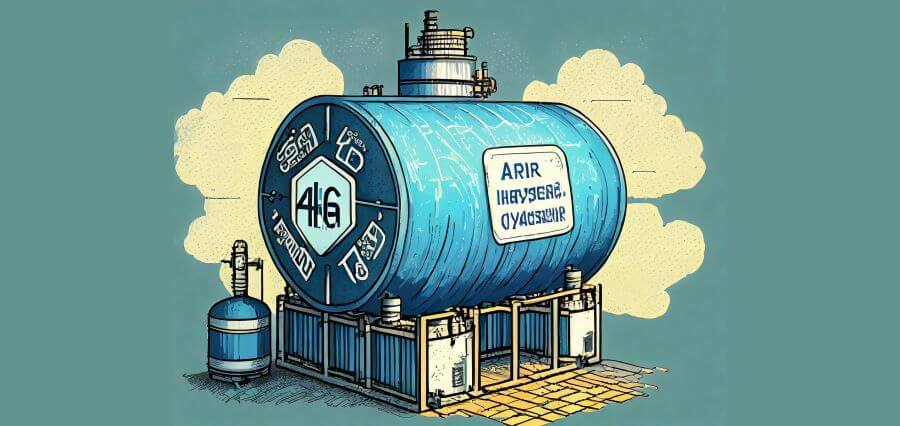Sustainability is gaining widespread acceptance in the power generation sector as countries and communities realize the significance of reducing their carbon footprints.
In this context, hydrogen has emerged as the most promising alternative to traditional fossil fuels. Being carbon-free and energy-efficient, it gets full marks for sustainability. The International Energy Agency (IEA) notes that hydrogen-based fuels could prevent up to 60 gigatonnes of CO2 emissions by 2050.
As of 2021, more than 50 large clean hydrogen projects operate worldwide, with a whopping combined investment of $75 billion. Despite the potential benefits of hydrogen as an energy transition fuel, its storage poses a big challenge to power plants. The reactive nature of the gas leads to safety concerns, while the sheer volume to be handled during energy generation also sounds problematic.
However, a proper storage plan can address these challenges. In this article, we will explain a few strategies that power plants can implement to eliminate the hazards of hydrogen storage.
Understand Potential Hazards
Since hydrogen is highly flammable, it can form explosive mixtures with air. It has a flammability range of 4-75% in air and a low ignition energy of 0.02 mJ. Detection and mitigation are challenging because its flames are almost invisible. Studies show that hydrogen can cause material failure, leading to leakage. A leak can mix with air to form a gas cloud that may explode on encountering an ignition source.
High-pressure leakage may result in spontaneous combustion and explosion even without ignition sources. In 2019, several such incidents occurred in the US, Norway, and South Korea. A fuel storage tank explosion in South Korea caused 2 deaths and injured 6 people severely. Understanding these inherent hazards can help plant owners design effective safety measures.
Seek Reliable Storage Technologies
Adopting advanced hydrogen storage technologies can help power plants mitigate risks and enhance safety. For example, solid-state storage immobilizes hydrogen within a solid matrix, minimizing the risk of leakage. Likewise, underground storage facilities can lower the threat of accidental releases.
According to H2MOF, efficient and safe storage requires ambient temperature and low pressure. With this approach, it is possible to safely store hydrogen for the long term and transport it across long distances.
Implement Robust Safety Protocols
Having the right technologies in place is a great start, but nothing matters more than implementing robust safety protocols when it comes to preventing and managing hydrogen-related incidents. Power plants and industrial establishments using hydrogen as a clean fuel must have a foolproof safety program to prevent disasters.
These include regular risk assessments, comprehensive staff training, and proper emergency response procedures. Installing sensors throughout the facility can help early detection of leaks or high environmental concentrations. While these safety protocols may be effective, they should be reviewed and realigned frequently to ensure coverage for all hazards in the evolving industry.
Create Passive Mitigation Systems
The Fukushima Daiichi Plant disaster in 2011 highlighted the inadequacy of inerting primary containment to protect plants against hydrogen explosions. Containment failure during a severe accident can cause the release of massive volumes of hydrogen into the reactor building. Eventually, it can mix with air and burn or explode.
Passive mitigation systems work as the most effective control strategy when it comes to managing the pressure and thermal loads on containment. Power plants must invest in explosion-resistant barriers to control leaks. Also, they should have safe venting systems to safely release hydrogen gas in the event of a leak. Flame arresters can prevent flashback in case of ignition.
Integrate Redundancies
Besides ensuring primary storage safety, power plants should integrate redundancies into their storage systems to improve reliability and resilience. It enables them to be ready for the worst. For example, they must have redundant safety valves, duplicate storage tanks, and backup power supplies for critical safety equipment.
Redundancies minimize the chances of system failures. Additionally, they increase the power plant’s ability to withstand unforeseen events and provide peace of mind to owners and workers facing daily threats.
In conclusion, switching to clean operations with hydrogen fuel is an excellent decision for power plants. However, its store presents unique challenges in terms of safety hazards linked with the characteristics of hydrogen. The best way to get the best of both worlds is to have a hazard mitigation plan in place. Implementing these safety measures can limit the risk, prevent disasters for power plants, and help them use hydrogen as a safe and clean energy alternative.


